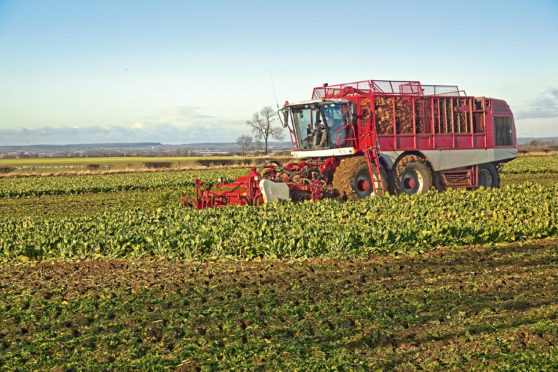A revival of the sugar beet crop in the east of Scotland could be on the cards after a report identified an opportunity for up to 50,000 acres to be grown on arable land in Angus, Fife, Perthshire and possibly Aberdeenshire.
Half a century on from the closure of Cupar’s sugar beet factory, a feasibility study will now investigate the steps required to re-establish the crop and a processing plant to produce bioethanol and help meet Scotland’s greenhouse gas reduction targets.
The move follows a Scottish Enterprise-commissioned report which estimated up to 50,000 acres of class 3.1 land or better would be required within a 30 to 60-mile radius of a refinery plant in eastern Scotland.
A Rural Innovation Support Service (Riss) stakeholders group will now look into the feasibility of the potential project, and interested farmers will shortly be given the opportunity to get involved.
Group facilitator Iain Riddell, from SAC Consulting, said stakeholders had the will, knowledge and capability to make the vision reality.
“A resurrected crop and a new refinery could offer a huge opportunity for agriculture to contribute to CO2 reduction and in the creation of new plant-derived products, but farmers will also have to factor in the feasibility, risk and reward of growing a crop that is new to most of them,” he said.
“We have experience of producing the closely related energy beet crops for anaerobic digestion (AD) and the growing of fodder beet for livestock, and it should be possible to grow sugar beet, but comprehensive trials will be required to assess yield, sugar content and hardiness of modern varieties in Scottish conditions.”
Other challenges have also been identified, not least the potential for soil compaction associated with the crop’s late, wet harvesting conditions.
Collaborators include Scottish Enterprise, The James Hutton Institute (JHI), the farm co-operatives group Saos and IBioIC.
Scottish Enterprise director David Smith said positive action and creative thinking was required to achieve net-zero emissions by 2045.
He said: “If this project is successful, the environmental benefits of sugar beet as an alternative manufacturing feedstock will be investigated for use across a wide range of sectors, instead of traditional fossil-based feedstocks, to make manufacturing more sustainable and in addition provide new opportunities for Scottish agriculture.”
JHI AgriFood lead, Professor Derek Stewart, added: “Scottish farming is progressive, and a resurrection of sugar beet production could both diversify farm incomes whilst helping to deliver to the Scottish climate change targets.”
